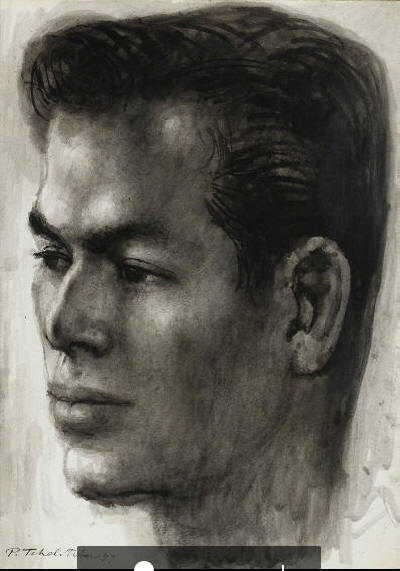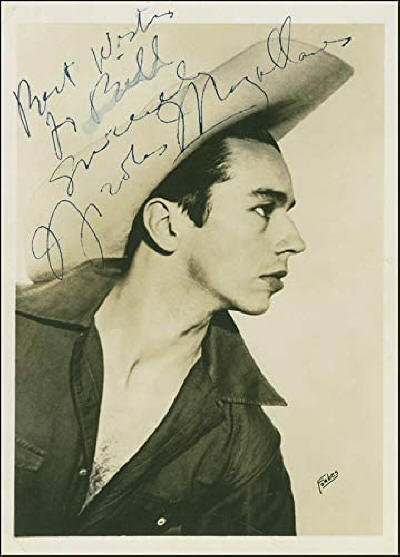Queer Places:
633 E 9th St, New York, NY 10009
630 and 610 E 11th St, New York, NY 10009
 Nicholas Magallanes (May
31, 1917 – May 2, 1977) was a principal dancer and charter member of the New York City Ballet.[1] Along with Francisco Moncion, Maria Tallchief, and Tanaquil Le Clercq, Magallanes was among the core group of dancers with which
George Balanchine and
Lincoln Kirstein formed Ballet Society, the immediate predecessor of the New York City Ballet.[2]
Magallanes remained with Balanchine and Kirstein throughout his long careers. Magallanes was discovered by Kirstein’s painter friend
Pavel Tchelitchev, roaming the streets of New York. Tchelitchev not only used him as central figure in his large painting Phenomena, but brought him to Kirstein to study dance. He immediately showed talent and became one of the leading dancers of what eventually became the New York City Ballet.
Nicholas Magallanes (May
31, 1917 – May 2, 1977) was a principal dancer and charter member of the New York City Ballet.[1] Along with Francisco Moncion, Maria Tallchief, and Tanaquil Le Clercq, Magallanes was among the core group of dancers with which
George Balanchine and
Lincoln Kirstein formed Ballet Society, the immediate predecessor of the New York City Ballet.[2]
Magallanes remained with Balanchine and Kirstein throughout his long careers. Magallanes was discovered by Kirstein’s painter friend
Pavel Tchelitchev, roaming the streets of New York. Tchelitchev not only used him as central figure in his large painting Phenomena, but brought him to Kirstein to study dance. He immediately showed talent and became one of the leading dancers of what eventually became the New York City Ballet.
Magallanes was born in Santa Rosalia de Camargo, now known as Camargo City, in the eastern part of the Mexican state of Chihuahua. He moved with his parents to the United States when he was five years old, first to New Jersey and then to the Lower East Side of New York City.
He was spotted at the New York Boys' Club on East Tenth Street by Pavel Tchelitchev, who recommended him to Lincoln Kirstein as a scholarship student at the fledgling School of American Ballet.[3] A handsome youth, with dark Latin looks and a strong, muscular physique, he auditioned for Balanchine and was accepted into the school in 1938. Under the tutelage of Balanchine and Pierre Vladimiroff, he soon began to show promise as a performer. He first appeared on stage in American Ballet Caravan's production of A Thousand Times Neigh, a tribute to the automobile, at the Ford pavilion at the 1939 New York World's Fair. Thus began his lifelong association with the enterprises of Balanchine and Kirstein.[4]

by George Platt Lynes

by Pavel Tchelitchev

Phenomena by Pavel Tchelitchev



In 1940, Magallanes danced briefly with the Littlefield Ballet, directed by Catherine Littlefield, and toured South America the following year with American Ballet Caravan.[5] Back in the States, he appeared on Broadway in Balanchine's dances in two musical shows, The Merry Widow (1943) and Song of Norway (1944).[6] On Broadway he also appeared in Ruth Page's dances in Music in My Heart (1947).[7] Earlier in the decade he performed in La Vie Parisienne (1942) to the music of Jacques Offenbach.[8] He then danced with Ballet Russe de Monte Carlo (1943–1946), when Balanchine was ballet master.[9] During this time he collaborated with Balanchine to create several roles including: The Poet in La sonnambula (The Night Shadow), Cleónete in Le Bourgeois Gentilhomme and Jean de Brienne in Raymonda.[10] Subsequently, he danced with Balanchine's Ballet Society (1946–1948). From 1948 until shortly before his death in 1977, he was a principal dancer with the New York City Ballet.[11]
/p>
Besides the many original roles that he created, Magallanes danced in almost every ballet in the New York City Ballet repertory. He was closely associated with Balanchine's Serenade, Concerto Barocco, Symphony in C, and The Four Temperaments.[16] Along with Orpheus, with Magallanes in the title role, Concerto Barocco and Symphony in C were on the program of the inaugural performance of the New York City Ballet on October 11, 1948 at the New York City Center of Music and Drama.[17][18][19] After almost thirty years, his last appearance with the company was in 1976, in the mime role of Don Quixote in Balanchine's ballet of the same name (Don Quixote).[20][21]
In 1951 Magallanes appeared with Tanaquil Le Clercq in the CBS TV special Premier.[22] He also danced in the live premier of the first opera composed for television in America – Amahl and the Night Visitors on the debut of the Hallmark Hall of Fame show for the NBC network in the role of the Dancing Shepherd (1951).[23] In later years he was also featured on several other broadcasts including: Camera Three for CBS as Prince Siegfried in Swan Lake (1956), Omnibus in A Midwinter Night's Dream (1961) and episodes of The Bell Telephone Hour for NBC (1962–1964).[24] His performances on film included a collaboration with Tanaquil Le Clercq dancing La Valse (1951) and with Louis Falco in a production of Dionysus in the role of Pentheus (1963).[25][26] In 1967 he also collaborated with Suzanne Farrell, Edward Villella and Francisco Moncion in Balanchine's A Midsummer Night's Dream dancing the role of Lysander.[27][28][29]
MMagallanes was often paired with Maria Tallchief. In one instance, he saved the opening night performance of Balanchine's elaborate production of The Nutcracker on February 2, 1954. Balanchine had choreographed the grand pas de deux for Tallchief and
André Eglevsky, but at the eleventh hour Eglevsky injured his ankle and was unable to perform. With no understudy on standby, Magallanes learned the technically challenging part in one day's rehearsal and danced the Cavalier of the Sugar Plum Fairy.[30][31]
Magallanes embodied the Balanchinian archetype with the melancholy heroes of Serenade, La Valse, and La Sonnambula.[32] He performed Orpheus, opposite Francisco Moncion as the Dark Angel and Tallchief as Eurydice. A set of photographs of the trio by George Platt Lynes suggests the drama of their interrelationships.[33][34]
Magallanes died of lung cancer at his home in North Merrick, Long Island at the age of 54.[35]
/p>
In 2013, Magallanes figured as a character in Nikolai and the Others, a play by Richard Nelson produced by the Lincoln Center Theater and presented at the Mitzi E. Newhouse Theater in New York. Depicting a gathering of Russian éemigré artists in the 1940s, the play includes a scene in which Balanchine choreographs Orpheus on Magallanes and Tallchief as Stravinsky looks on. Magallanes and Tallchief were played by Michael Rosen and Natalia Alonso; Balanchine was portrayed by Michael Cerveris. The play had a short run and was not a critical success.[36]
My published books:


 Nicholas Magallanes (May
31, 1917 – May 2, 1977) was a principal dancer and charter member of the New York City Ballet.[1] Along with Francisco Moncion, Maria Tallchief, and Tanaquil Le Clercq, Magallanes was among the core group of dancers with which
George Balanchine and
Lincoln Kirstein formed Ballet Society, the immediate predecessor of the New York City Ballet.[2]
Magallanes remained with Balanchine and Kirstein throughout his long careers. Magallanes was discovered by Kirstein’s painter friend
Pavel Tchelitchev, roaming the streets of New York. Tchelitchev not only used him as central figure in his large painting Phenomena, but brought him to Kirstein to study dance. He immediately showed talent and became one of the leading dancers of what eventually became the New York City Ballet.
Nicholas Magallanes (May
31, 1917 – May 2, 1977) was a principal dancer and charter member of the New York City Ballet.[1] Along with Francisco Moncion, Maria Tallchief, and Tanaquil Le Clercq, Magallanes was among the core group of dancers with which
George Balanchine and
Lincoln Kirstein formed Ballet Society, the immediate predecessor of the New York City Ballet.[2]
Magallanes remained with Balanchine and Kirstein throughout his long careers. Magallanes was discovered by Kirstein’s painter friend
Pavel Tchelitchev, roaming the streets of New York. Tchelitchev not only used him as central figure in his large painting Phenomena, but brought him to Kirstein to study dance. He immediately showed talent and became one of the leading dancers of what eventually became the New York City Ballet.





